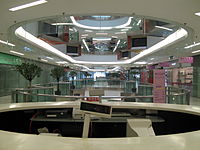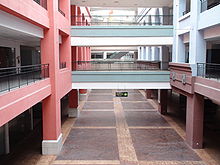- Dead mall
-
A dead mall or greyfield[1] is a shopping mall with a high vacancy rate or a low consumer traffic level, or that is dated or deteriorating in some manner.[2] Many malls in the United States are considered "dead" when they have no surviving anchor store (often a large department store) or successor that could serve as an entry into or attraction to the mall.[3] Without the access, the small stores inside are difficult to reach; without the pedestrian traffic that a department store generates, sales volumes plummet for the stores, and rental revenues from those stores can no longer sustain the costly maintenance of the malls.[4]
Contents
Changes in the retail climate
In many instances, a mall begins dying when the mall's surrounding neighborhood undergoes a socio-economic decline or a newer, larger mall opens nearby. Structural changes in the department store industry have also made survival of these malls difficult: A few large national chains have replaced many local and regional chains, and some national chains (Montgomery Ward, Woolworth's) have gone out of business. Hence, in some areas there aren't enough traditional department stores to fill all the existing anchor spaces. Newer "big box" chains (such as Walmart, Target and Best Buy) normally prefer to occupy free-standing buildings rather than mall-anchor spaces.
Attitudes about malls are also changing. With changing priorities, people have less time to spend driving to and strolling through malls, and in the current economic climate, the specialty stores offer what many shoppers see as useless luxuries they can no longer afford. In this respect, big box stores and conventional strip malls have a time-saving advantage.[5] The rise in big box stores since the 1980s left malls reliant on an older business model that couldn't change with the times. 21st-century retailing trends favor open air lifestyle centers, which resemble elements of power centers, big box stores, and strip malls over indoor malls. The massive change led Newsweek to declare the indoor mall format obsolete in 2008.[6]
However, some malls have managed to maintain profitability, particularly in areas with frequent bad weather or large populations of senior citizens who can partake in mall walking.[7] Combined with lower rents, these factors have led to companies like Simon Malls enjoying high profits and occupancy averages of 92%.[8] Some retailers have also begun to re-evaluate the mall environment, a positive sign for the industry.[9]
Although "dead malls" are a current (2011) issue, it is by no means a new one, as many malls have failed and closed over the decades. For example, Dixie Square Mall in Harvey, Illinois closed in 1978-79 after only 12 years in operation (see "Unconventional uses", below).
An empty corridor in the mostly vacant New South China Mall, one of the symptoms of the Chinese property bubble.
Redevelopment
Dead malls are occasionally redeveloped. Leasing or management companies may change the architecture, layout, decor, or other component of a shopping center to attract more renters and draw more profits. Sometimes redevelopment can involve a switch from retail usage to office or educational use for a building (such as is the case with Park Central Mall in Phoenix, and the Eastmont Town Center in Oakland, California.
As a last resort, the structure is demolished and the property redeveloped for other uses, known as building on a greyfield site. In places such as Vermont with a strict permitting process, and in major urban areas where open fields are long gone, this can be much easier and cheaper than building on a greenfield site.
Unconventional uses
One of the most famous dead malls is the Dixie Square Mall in Harvey, Illinois, which was featured in the 1980 movie The Blues Brothers. The car chase scenes were filmed at Dixie Square after the mall had been closed, and filmmakers had to dress the mall to make it appear functional and open for business. Over thirty years later, the crumbling building is still standing because of low demand for site redevelopment.
See also
References
- ^ "Greyfields and Ghostboxes Evolving Real Estate Challenges". Uwex.edu. http://www.uwex.edu/CES/cced/downtowns/ltb/lets/0503ltb.html. Retrieved 2009-07-16.
- ^ Wal Street Journal
- ^ Newman, Rick (2009-06-26). "How To Tell When a Mall Is In Trouble". News.yahoo.com. http://www.usnews.com/money/blogs/flowchart/2009/06/26/how-to-tell-when-a-mall-is-in-trouble.html. Retrieved 2009-07-16.
- ^ New York Times
- ^ "The vanishing shopping mall". The Week. 2009-03-26. http://www.theweek.com/article/index/94691/The_vanishing_shopping_mall. Retrieved 2009-10-24.
- ^ Dokoupil, Tony (2008-11-12). "Is the American Shopping Mall Dead?". Newsweek. http://www.newsweek.com/id/168753. Retrieved 2009-10-24.
- ^ . http://walking.about.com/od/beginners/a/mallwalking.htm.
- ^ . http://www.ibj.com/next-up-general-growth/PARAMS/article/15096.
- ^ . http://www.muscatinejournal.com/news/local/article_9f256182-6a7f-11df-989a-001cc4c03286.html.
External links
Categories:- Shopping malls
- Defunct shopping malls
Wikimedia Foundation. 2010.




